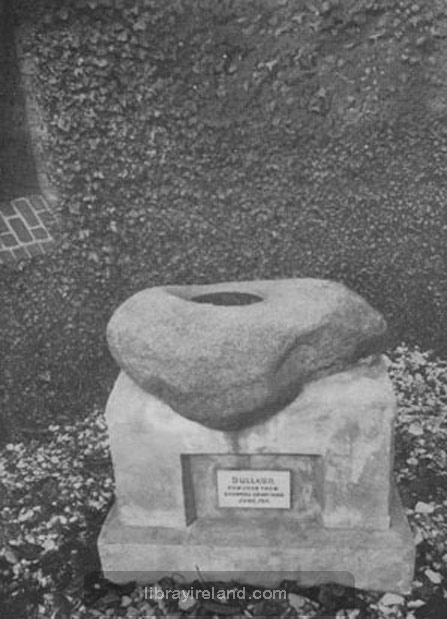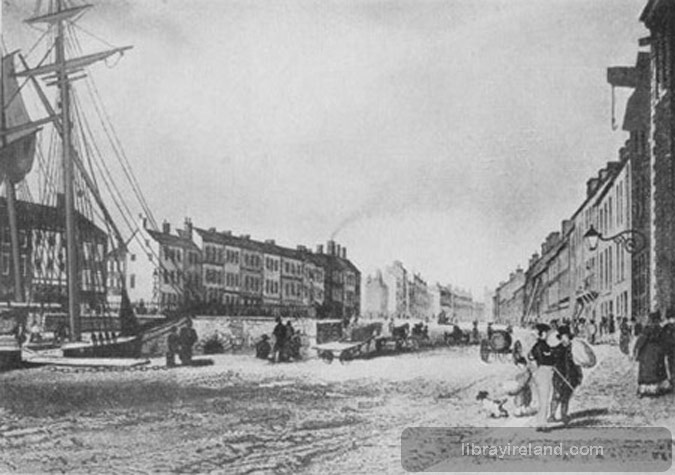Early Churches - Story of Belfast
THE first church of which we have any record was called the "Church of St. Patrick of the White Ford," and later on, it was known as Shankill, or the Old Church. It was a place of great importance, for we are told that it had six "Alterages" or small churches attached to it, so Shankill was really the mother church of Belfast. There is not a vestige left now of the church, and an unsightly mound marks the spot where it once stood. The old graveyard is still very occasionally used by those families who possess a right of burial there, but the ground is more than full. The ancient font which lies in the graveyard is formed out of a solid block of stone about three feet square with a hole cut in it. This ancient font is now used by the children of the district for a very curious purpose, and it is looked upon with reverent awe, as it is believed that it has marvellous powers of healing. Any child who has a wart sticks a pin into it, and then drops the pin into the hole in the stone, and the wart is cured. How frequently this is done may be seen from the solid layers of pins lying in the stagnant water which half fills the cavity. The font, which dates from the year 1413, is now re-named the Wart Stone. In the year 1911, it was removed to St.. Matthew's Church, and set up on a pedestal at the entrance door.
A curious old watch tower is still to be seen. It was built for the watchmen who were there for the purpose of guarding any newly-made graves, and it recalls the horrors of the time of Burke and Hare, who were imitated in many large towns. When a funeral took place, the grave was opened and the dead body was taken out and sold to medical students at the College for dissection purposes.
The nearest church to Shankill was mentioned in 1306 as being one of the "Alterages." It was the "Chapel of the Ford," afterwards known as "The Corporation Church." It was the church to which the Sovereign and the members of the Town Council went in state on Sundays. We know it now as St. George's Church in High Street.
The old Chapel of the Ford was a small building close to the river. High tides flowed over the graveyard, and small boys used to sit on the wall and catch fish.
The Chapel of the Ford was largely used by travellers who entered the church to offer prayers for a safe journey before they dared to venture on the dangerous crossing of the river Lagan, for it was a hazardous undertaking in those days. We have no record of any returning travellers offering thanksgiving prayers when the danger was over. History is modest as well as silent on this point.
The old church weathered through many stormy scenes, and it shared the common fate of the country. It was broken down and repaired again and yet again, and was finally rebuilt as the Parish Church of Belfast. The graveyard was extensive and occupied a large square space, bounded by Church Lane, Ann Street, Forest Lane—now Victoria Street—and High Street. It was the principal burying place for the oldest families in Belfast, and many monuments were built along the inside of the boundary walls. It was here that the remains of the unfortunate Henry Joy McCracken were interred. Stirring times were those of the Cromwellian party, and the Protector left a trail of dire disaster wherever he went in Ireland. Cromwell did not come so far as Belfast. He never passed Drogheda, but he sent a strong force under the command of Colonel Venables to take possession of the town. He ordered Belfast to surrender, but Belfast refused, and he besieged the town for four days, when some agreement was made, and he entered the town. Old history states there was a short battle fought in some fields between the present Donegall Street and York Street. This was confirmed many years after when a cotton mill was built there, and marks of entrenchments were discovered, and also some cannon balls and ammunition found. This was the only time that Belfast was ever besieged. The Sovereign at that time was Mr. George Martin. He refused to find accommodation for Cromwell's army, so they destroyed his house and seized his property, and he was obliged to leave the country. Colonel Venables fortified the Corporation Church and re-named it "The Citadel." It was probably the most important building in the town, and the fact of its being a sacred edifice never cost the Cromwellians a single thought.
A curious scene took place one Sunday morning. Cromwell appointed the Rev. William Dix to preach, but another clergyman, the Rev. Henry Livingstone objected so strongly that he went up into the pulpit and forcibly ejected Mr. Dix, and we are not told who conducted the service on the following Sunday. Henry Cromwell gave £100 afterwards towards the repairs of the church. After the Restoration, it was put into proper order, and remained until 1774 as the Corporation Church, when old age and infirmity rendered it unsafe, and all the privileges of the Parish Church were transferred to St. Anne's. The Marquis of Donegall built St. Anne's at his own expense, and also presented an organ. He spent £10,000 on the church and named it St. Anne's in memory of his beloved wife. St. George's was built upon the site of the old church in High Street, and the lofty pillars along the front were brought from Ballyscullion, one of the palaces built by the Earl of Bristol when he was Bishop of Derry. The long line of " Vicars of Belfast," as the incumbent of St. Anne's was termed, shows many very important names. The Rev. William Bristow was also Sovereign as well as Vicar. He held the position of Sovereign with such discretion and dignity during a most trying period of the town's history, that he was re-elected ten times. He preached the last sermon in St. George's as the old parish church, and also preached the first sermon in St. Anne's, the new parish church.
In the year 1801, we read of a curious circumstance, which would cause a great sensation if such were permitted now. Mr. Incledon, who was considered the greatest singer of his time, was engaged for nine nights. He offered to sing on behalf of the funds of the Poorhouse. The performance was held at three o'clock on Sunday when the church service was over, and a selection of sacred music from Handel's Oratorios was given in St. Anne's Church—"Admittance 3 British Shillings." We are told that the sum of £81 11s. 4d. was raised from this Sunday concert.
Another innovation occurred when a collection was taken for the Poorhouse School. The five principal ladies in Belfast acted as collectors: The Marchioness of Donegall, Lady Mark Kerr, Lady Harriet Skeffington, Mrs. Dickson and Mrs. Drummond. They were attended by the Marquis of Donegall, Lord Mark Kerr, William Skeffington, General Drummond and the Sovereign. The amount of the collection proved most satisfactory, and we can well believe the attendance at church on that particular Sunday was also satisfactory.
St. Anne's still exists, but it is now known as St. Anne's Cathedral. The foundation stone of the new building was laid in 1889 by the late Countess of Shaftesbury. It is still in an unfinished state, but when it is completed it will be a very fine building.


